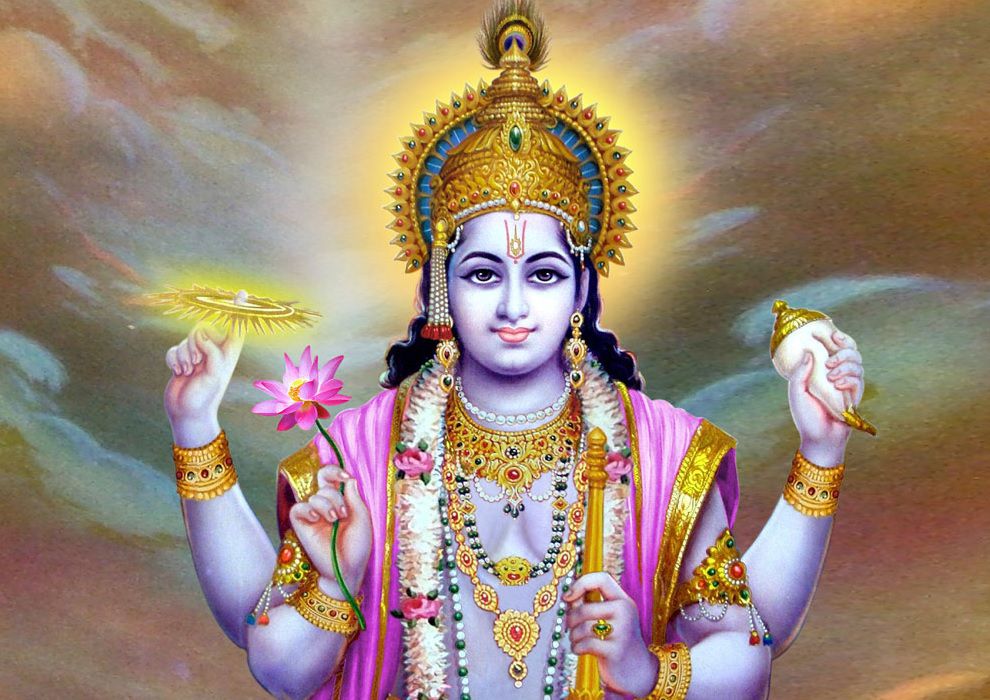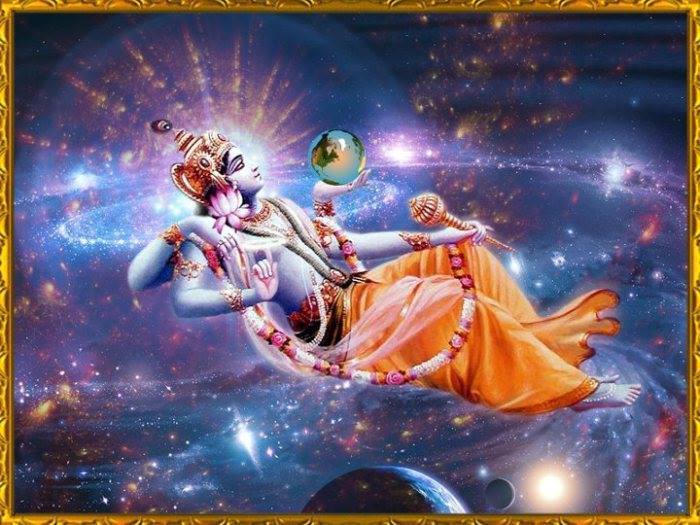No products in the cart.
We may always wonder when watching devotional programmes or on seeing calendars with images of Hindu gods, that why is Lord Vishnu colored blue? And what makes him special?
To answer that one should first understand what Vishnu, the preserver of the systems, one among the Trimurtis, represents and does.
Lord Vishnu is seen as the divine arbitrator. He protects justice and moral order by mediating disagreements, whether they involve humans or gods. He is an archetype you might call on when seeking patience; you might identify with his gentle, merciful nature.
One third of the trinity of gods who represent the three phases of cosmic existence, Vishnu sustains the universe and upholds its many laws.
Vishnu is typically depicted with sky-blue skin. He also has four arms: a pair at the front of his body representing his physical presence in the material world, and two at the back symbolizing his existence in the spiritual realm. In each hand he holds an object: a lotus that represents purity and beauty, a conch shell that stands for the sacred Om sound, mace for strength and the destruction of evil, and a chakra that symbolizes the mind, intelligence, and the end of self-delusion.
Images and statues of Vishnu often show him in a vast ocean, resting atop a hundred-headed cobra called Sheshnag, which represents the many desires of the mind. Vishnu sits over them, showing that he has control over these desires rather than being dominated by them.
According to Hindu belief, Vishnu has incarnated on Earth at least nine times to destroy evil and restore justice in the world, part of his Dashavatar. Each time he comes as a different manifestation or avatar and serves a different purpose.
As Matsaya, a fish, Vishnu saves the Vēdas, the Hindu texts containing all the knowledge of the world, from massive floods that threaten the earth. When he appears as Kurma, a tortoise, Vishnu recovers the valuable things that were lost at the bottom of the ocean during the floods, including the nectar of immortality.
Vishnu incarnates as Varaha, a boar, and battles the demon Hiranyakasha, who pulled the earth to the bottom of the ocean. Varāha dives into the depths of the sea and brings the earth back to safety.
Vishnu then returns as Narasimha, a being with the head and claws of a lion and the body of man; as Vamana, a dwarf, to conquer King Bali; and as Parshuram, a fierce warrior. In the incarnation as Parashurama, Vishnu uses his axe to kill Kartavirya, a king with a thousand arms who stole Parshurama’s father’s holy calf.
Another incarnation of Vishnu includes Rāma, a king and an ideal man, a Maryada Purushottam. Lord Rāma is said to be the seventh incarnation of Vishnu and the main character in the classic Hindu epic the Ramāyana. Lord Rama represents righteousness, truth, and strength of character. This representation is not known for a single mission or triumph, but for holding on to his ideals in the face of many challenges. Rāma has been given the status of a God by Hindu followers.
And another incarnation is that of Krishna, the deity. Like Rāma, Lord Krishna is also revered as a God in the Hindu faith. However, Krishna is seen as more playful, endearing, and accessible than Lord Rama, who is known for the fact that he personifies perfection. There are many tales about Krishna’s pranks and love escapades with the cow maidens. As the eighth incarnation of Vishnu, Krishna is also the protagonist in another Hindu epic, the Mahabharata. At a very young age, Krishna slays a number of powerful demons, including Kansa, the king of the snakes. According to tradition, Krishna is the only incarnation of Vishnu who was aware of his divine powers from infancy. For this reason, Krishna is commonly equated with Vishnu rather than being considered only an incarnation.
In some branches of Hinduism, Gautama Buddha is believed to be the ninth incarnation of Vishnu, while others state that Balarama, Krishna’s brother, is the ninth avatar.
Kalki, the prophesied God, is the 10th representation of Vishnu, who has not yet appeared on Earth. When Kalki arrives, it is said that he will come to destroy evil and restore the moral order of humanity by the end of the Kali Yuga period, the current era in the Hindu calendar. Since we are only 5,000 years into Kali Yuga, which is said to last 432,000 years, it may be a long time before the Kalki avatar appears!
As you can see Lord Vishnu sustains and preserves the universe and is omnipresent. Symbolism says that the color blue attributed to Lord Vishnu is to emphasize and represent that he is Infinite like sky and ocean. Sanatan Dharma places a huge emphasis on teaching through representations of anything and everything that concerns them. Vishnu is as an infinite force. He has no form, no name, and thus he is incommensurable. The blue color is a representation of this. The blue color also represents Vishnu’s cosmic dimensions and his connection with the Vedic gods of rain and thunder and his relationship with the earth.
Swami Vivekananda says
“The God of Infinite Love and the object of Love sublime and infinite are painted blue. It is a natural law that anything sublime and infinite is associated with blue colour. Take a handful of water, it is absolutely colourless. But look at the deep wide ocean; it is as blue as anything. Examine the space near you; it is colourless. But look at the infinite expanse of the sky; it is blue.”
Besides, Vainkuntha is the eternal home/abode of supreme lord Vishnu. The glimpse of Vainkuntha is described in Bhagavat Puran as follows:-
“The inhabitants of the Vaikuntha planets are described as having a glowing sky-bluish complexion…..
…..and all these combined together appear just like the sky decorated with both clouds and lightning.”







